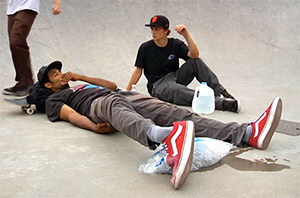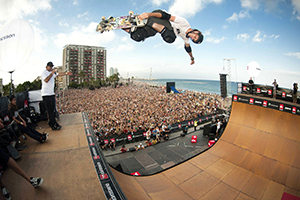 |
| Here's a young man who broke his leg terribly while skateboarding in a skatepark just like the one Niagara Falls Mayor Paul Dyster is building in Hyde Park. Skatepark developer Aaron Spohn says the installations can last 50 years with proper maintenance, thus guaranteeing Niagara Falls taxpayers another half century of expensive litigation. |
 |
| An accident waiting to happen? You bet! That's why Tony Hawk, whose $10,000 grant got Niagara Falls Mayor Paul Dyster and Community Development Director Seth Piccirillo to fall for the skatepark flim flam, and Aaron Spohn, who is actually designing the park, have a no liability clause in their contracts. Too bad city taxpayers can't get a no liability agreement to shield them from politicians making stupid decisions. |
 |
| Here's a picture of skateboard millionaire Tony Hawk risking death for the edification of what looks to be a couple thousand people in the audience on a beach in Southern California. He likes Niagara Falls, because the yokels who run the city government here are even stupider than their counterparts in Beaver Dam, Wisconsin! They bought his skatepark pitch hook, line and sinker, and now he is considering introducing Niagara Falls Mayor Paul Dyster to the wonders of the Hula Hoop. |
 |
| When he wants to look cool, Niagara Falls Mayor Paul Dyster wears a Hard Rock Café T shirt. His closet also includes a jersey that makes him look like a hockey player, one that depicts cartoon character Jiminy Cricket swooning in the arms of Harriet Tubman and now, one that makes his appear to be a hip skateboard dude! |
|
|
|
|
|
When a skateboarder breaks a leg or an arm, snaps his or her spine or fractures a skull at Mayor Paul Dyster’s new skatepark, who will be liable to pay the costs associated with treatment, pain and suffering?
It won’t be skateboarding guru Tony Hawk, whose $10,000 grant spurred Dyster and Community Development Director Seth Piccirillo to build the park, and it won’t be master skateboard park designer and builder Aaron Spohn.
Both of them have contracts absolving them of any liability in accidents and injuries that occur at the facility.
The tab will be paid and the lawsuits resolved with money taken from Niagara Falls taxpayers. Dyster is “leading” the city into a quagmire of litigation that may last 50 years or more so that he can pick up a few votes in the September 10 primary election.
Skateboarding is an adrenaline filled sport and pastime that carries with it the risk of falling. Common injuries from skateboarding accidents include lower limb, upper limb, spinal and hip injuries. Serious injuries increase the higher the jumps and the faster the speed of travel.
Between 2000 and 2011, skateboarding caused 129,000 head and neck injuries, according to the New York Times.
Skateboard-related injuries account for an estimated 50 000 emergency department visits and 1500 hospitalizations among children and adolescents in the United States each year.
According to the U.S. Consumer Product Safety Commission, fractures are frequent, and deaths are also reported.
Neurosurgeon Dr. David Shafron said skateboard injuries are common among patients he sees annually, with concussions ranking highest among these injuries.
"Concussions are by far the most common thing I see, meaning their level of alertness has been altered in any way, they are not necessarily knocked out," he said. "I usually get more involved when there’s a loss of consciousness or skull fracture."
In a 2001 study, the most common fractures were of the ankle and wrist. Older patients had less severe injuries, mainly sprains and soft tissue injuries. Most children were injured while skateboarding on ramps and at arenas; fewer than 10 percent were injured while skateboarding on roads. Some 37 percent of the injuries occurred because of a loss of balance, and 26 percent because of a failed trick attempt. Falls caused by surface irregularities resulted in the highest proportion of the moderate injuries.
Spohn, who will design and likely build the skatepark here, states that concrete parks such as the one planned for Hyde Park can easily last 30 or even 50 years with routine maintenance.
While both Dyster and Piccirillo have stressed that the $100,000 being used to build the park came out of federal Community Development Block Grant funding and therefore is not – technically – local taxpayer money, every single dime used to settle the hundreds of lawsuits likely to be filed over the next half century will most certainly be.
That is if anyone still knows what a skateboard is by then.
Hula Hoops, anyone?




